Physical Address
304 North Cardinal St.
Dorchester Center, MA 02124
Physical Address
304 North Cardinal St.
Dorchester Center, MA 02124
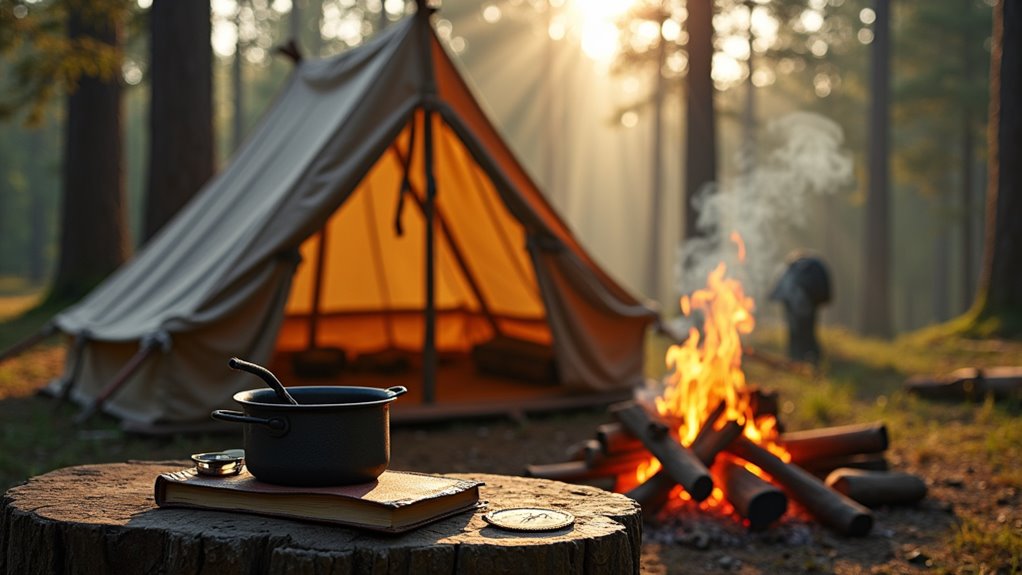
Witness how camping evolved from Native American survival traditions to today's glamping craze through twelve surprising historical moments that changed America forever.
You might think camping’s just about pitching tents and roasting marshmallows, but America’s outdoor traditions run much deeper than weekend getaways. From Native American seasonal migrations to today’s luxury glamping resorts, camping has shaped how we connect with nature and each other. These twelve pivotal moments reveal how wars, automobiles, and cultural shifts transformed a survival necessity into the billion-dollar recreation industry that defines modern outdoor adventure.
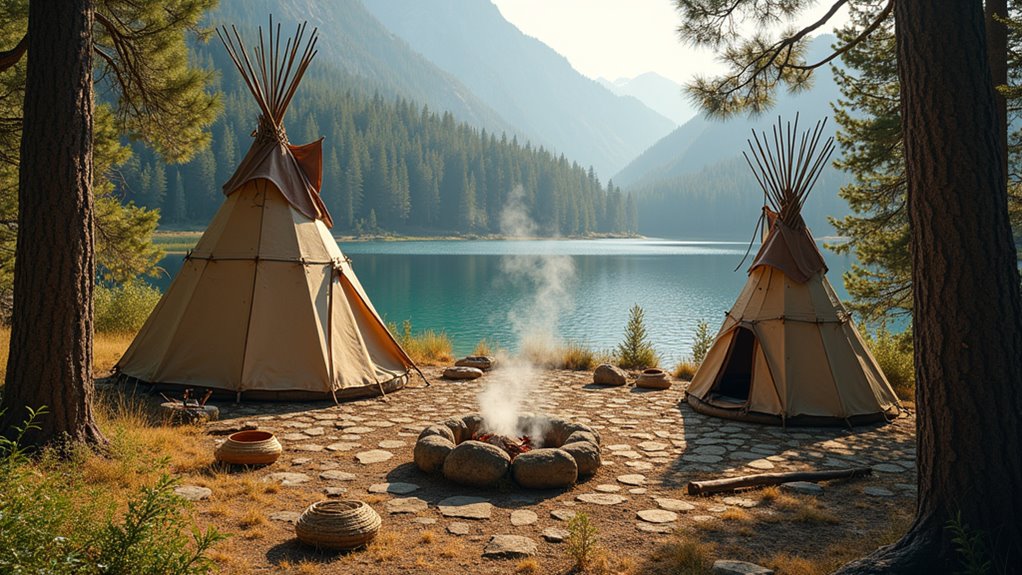
Long before modern recreational camping existed, Native American tribes across North America perfected the art of seasonal camping out of necessity and deep cultural connection to the land. You’ll find their practices shaped everything you know about outdoor living today.
Native American tribes mastered seasonal camping through necessity and cultural connection, creating the foundation for all modern outdoor living practices.
They’d move strategically with seasons, following game migrations and harvest cycles. Their portable shelters—tipis, wigwams, and lean-tos—inspired modern tent designs you use now.
You can trace camping essentials directly to their innovations: weatherproofing materials, fire management techniques, and food preservation methods. They understood Leave No Trace principles centuries before the movement existed, moving camps to prevent overuse.
Their knowledge of reading weather patterns, finding water sources, and selecting safe campsites became foundational skills every modern camper needs. These traditional practices created the perfect foundation for what would eventually become family camping adventures that bring multiple generations together in nature.
After the Civil War ended in 1865, battle-weary veterans brought military camping expertise to civilian life. They transformed outdoor living from a survival necessity into organized recreation.
You’ll find these former soldiers established the first structured camping groups, applying their field experience to create systematic approaches to outdoor living.
Veterans organized camping clubs throughout the Northeast, teaching civilians essential skills like tent setup, camp sanitation, and group coordination. They’d developed these competencies during wartime, now repurposing them for leisure activities.
This veteran-led movement laid the foundation for organized group camping that would eventually evolve into the structured camping experiences we recognize today.
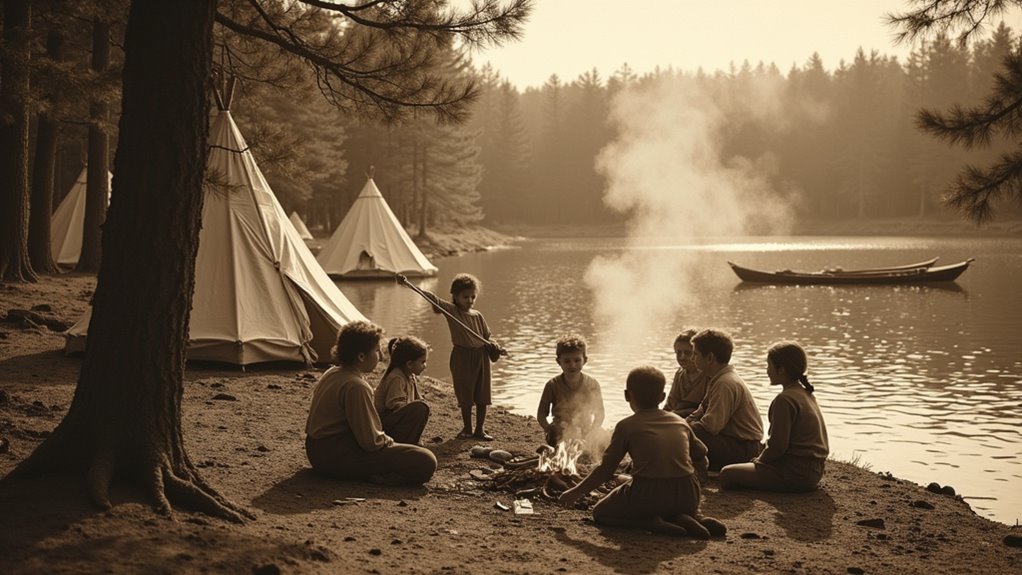
While Civil War veterans were transforming adult outdoor recreation, children’s camping had already begun taking shape through Frederick William Gunn’s pioneering efforts in Connecticut.
Frederick William Gunn established the blueprint for modern youth camping in 1861, years before Civil War veterans organized adult outdoor recreation programs.
You’ll find Gunn’s 1861 summer camp remarkable for its forward-thinking approach. As headmaster of Gunnery School, he took two dozen boys on a two-week wilderness adventure that established the foundation for modern youth camping.
Here’s what made Gunn’s camp groundbreaking:
Gunn’s innovation preceded organized adult camping by over a decade, proving children’s natural affinity for outdoor experiences when properly guided. The skills these early campers learned, including proper winter dressing techniques for outdoor survival, became essential knowledge that would benefit them throughout their lives.
The National Park Service, officially created in 1916, transformed how you experience the outdoors. Unlike private campgrounds, these destinations offered pristine wilderness access at affordable rates. You could pitch your tent beside geysers, under giant sequoias, or along dramatic coastlines. For those seeking more comfort during their outdoor adventures, RV camping provides an alternative that combines wilderness access with modern conveniences.
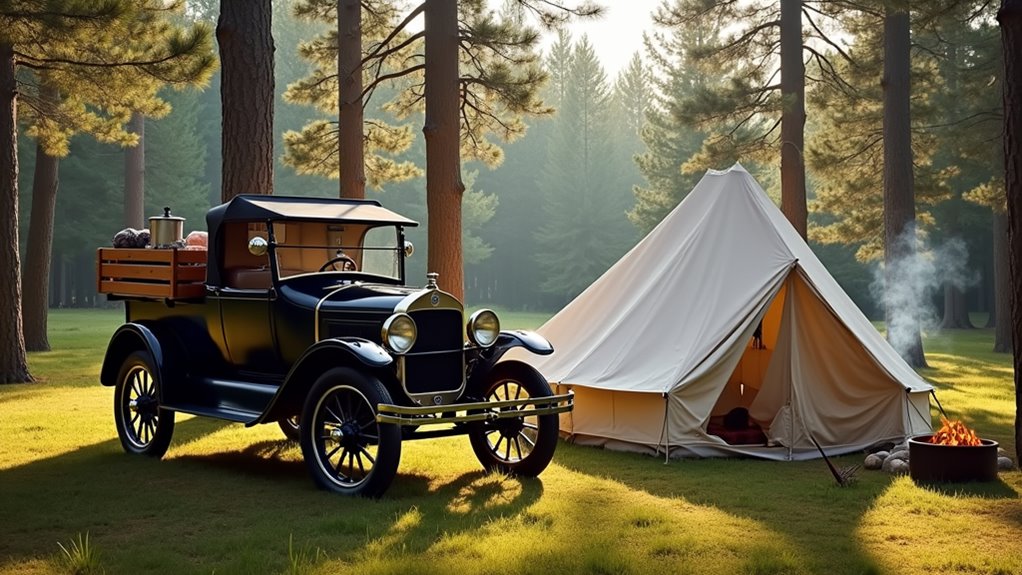
When Henry Ford’s assembly line made cars affordable for middle-class families, camping transformed from an elite wilderness pursuit into America’s favorite weekend escape. You could now pack your family and gear into your Model T and drive to destinations that previously required expensive train travel or arduous hiking.
The Model T turned camping from a rich man’s hobby into every family’s weekend adventure, democratizing the great outdoors for ordinary Americans.
The automotive revolution brought camping to the masses through:
This shift created modern recreational vehicle culture and established camping as an American tradition accessible to ordinary families seeking affordable outdoor adventures. Just as America developed its car camping culture, other countries were establishing their own iconic outdoor traditions, with Scotland creating world-renowned hiking trails that would eventually attract international adventurers.
As economic hardship gripped America in the 1930s, families discovered camping offered an affordable escape from financial stress without breaking already-strained budgets. You’ll find this era transformed camping from a leisure activity into a practical necessity for many households seeking inexpensive vacations.
During these tough times, you’d see families pitching surplus military tents in state parks for just twenty-five cents per night. Government programs like the Civilian Conservation Corps built affordable campgrounds with basic amenities, making outdoor recreation accessible to working-class Americans.
You’d pack simple meals, share campsites with other families, and create entertainment through storytelling and nature exploration.
This period established camping’s reputation as a democratic outdoor activity where you didn’t need wealth to enjoy nature’s benefits. Today, adventurous families continue this tradition of affordable outdoor recreation by exploring challenging activities like glacier climbing on America’s most spectacular frozen landscapes.
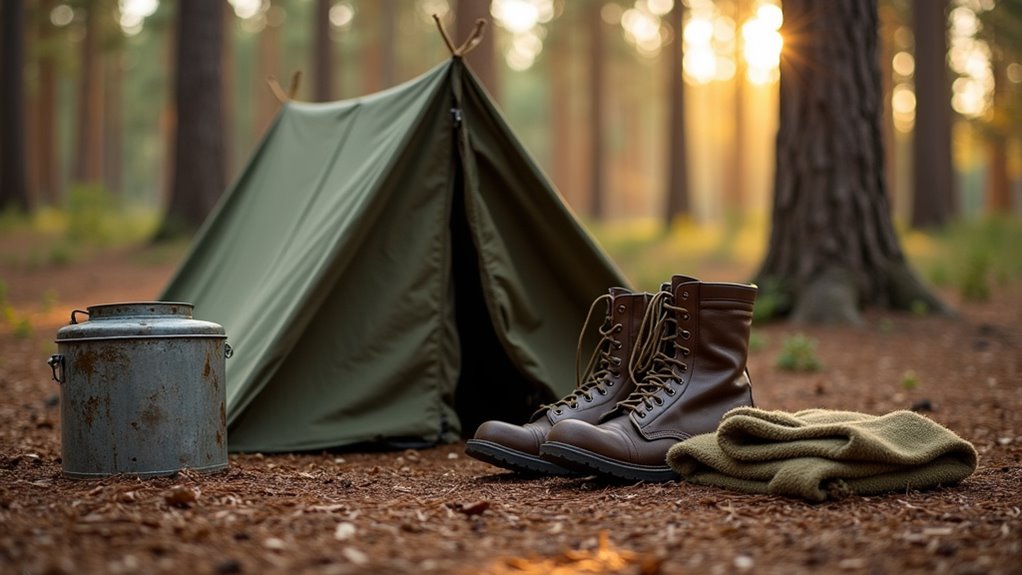
After World War II ended in 1945, you’d find military surplus stores overflowing with durable camping equipment that soldiers had tested in harsh conditions across multiple continents. This surplus gear revolutionized recreational camping by making high-quality equipment affordable for ordinary families.
Military surplus transformed camping from an elite pursuit into America’s favorite family pastime by flooding the market with battle-tested gear.
You could suddenly access military-grade camping essentials at a fraction of their original cost:
This military surplus boom democratized camping, transforming it from an expensive hobby into an accessible family activity that shaped America’s outdoor recreation culture. When planning your camping trip today, focus on acquiring essential camping gear rather than getting distracted by nonessential equipment that adds unnecessary weight and expense.
Before President Eisenhower signed the Federal-Aid Highway Act of 1956, you’d need days of careful planning and rugged determination to reach America’s most spectacular camping destinations.
The interstate system changed everything overnight. Suddenly, you could drive from Chicago to Yellowstone in comfort, transforming weekend camping from a local activity into a national adventure. These improved roads also opened access to previously unreachable rainforest hiking trails, allowing campers to explore America’s most remote wilderness areas with unprecedented ease.

The new highways weren’t just bringing people to campgrounds—they sparked an entirely new way to camp. Post-war prosperity gave American families disposable income and manufacturers responded with revolutionary recreational vehicles. You’d witness the birth of modern RV culture as companies mass-produced affordable travel trailers and motorhomes.
The RV boom transformed camping from rugged outdoor survival into comfortable mobile living:
You’re seeing camping evolve from tents to rolling hotels on wheels. This shift created an ongoing debate between traditionalists who preferred tent camping and those who embraced the convenience of recreational vehicles.
While RVs brought comfort to camping, a growing environmental consciousness began reshaping how Americans approached the wilderness. You’d witness this shift as Rachel Carson’s “Silent Spring” sparked nationwide environmental awareness in 1962. The movement taught you that camping wasn’t just about enjoying nature—you had a responsibility to protect it.
You’ll find this era introduced “Leave No Trace” principles that still guide outdoor ethics today. Don’t leave trash, minimize campfire impacts, and respect wildlife became the new camping commandments.
You’d see the Wilderness Act of 1964 designating protected areas where motorized vehicles couldn’t go, forcing campers to reconnect with simpler, more sustainable practices.
This consciousness transformed camping from conquest of nature to partnership with it, making you a steward rather than just a visitor. These foundational principles evolved into comprehensive guidelines that teach modern campers how to practice responsible camping while preserving natural spaces for future generations.
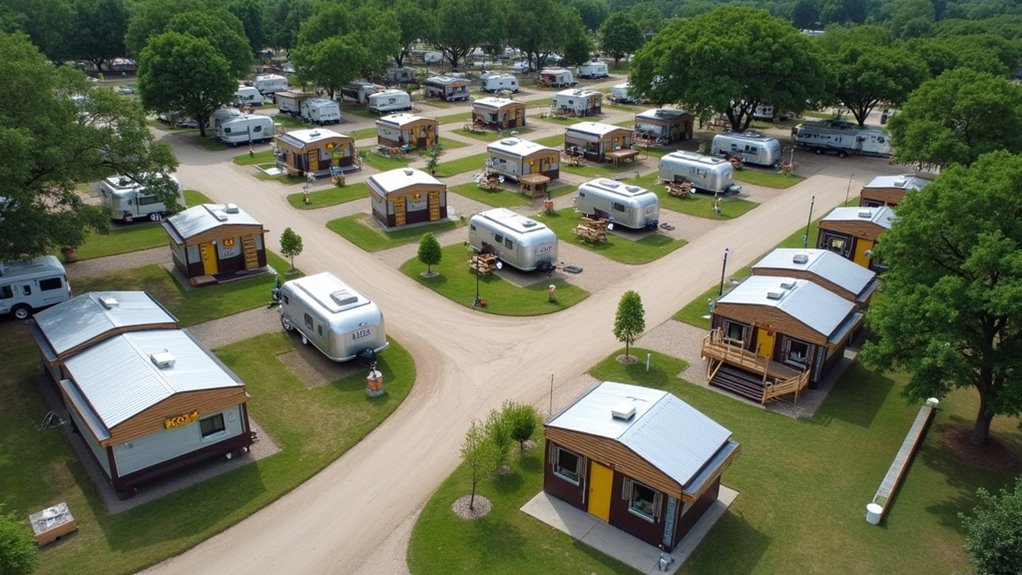
As environmental awareness grew, so did the need for organized camping facilities that could accommodate increasing numbers of outdoor enthusiasts responsibly. In 1962, Dave Drum founded Kampgrounds of America (KOA) in Billings, Montana, revolutionizing how you’d experience commercial camping.
KOA’s franchise model transformed the industry by establishing consistent standards across locations. You could now expect reliable amenities wherever you traveled:
This standardization addressed camping’s biggest challenge: unpredictable quality. You’d no longer wonder if basic facilities would be available.
KOA’s yellow signs became symbols of dependable outdoor hospitality, making family camping accessible to mainstream America. With spring camping season approaching, maintaining your RV’s appearance becomes essential for enjoying these established campground amenities to their fullest.
By the 2000s, outdoor recreation had evolved beyond traditional tent camping and RV parks to embrace “glamping”—glamorous camping that combines nature experiences with upscale accommodations. You’ll find safari tents with real beds, treehouses with electricity, and yurts featuring private bathrooms at glamping sites nationwide. This movement emerged as millennials sought Instagram-worthy adventures without sacrificing comfort.
You’re paying premium prices—often $150-500 per night—for curated outdoor experiences that eliminate camping’s traditional hassles. Popular glamping options include Airstream trailers, canvas safari tents, tiny houses, and converted shipping containers.
The trend reflects America’s growing desire for experiential travel and work-life balance. You don’t need camping gear or outdoor skills; glamping operators provide everything from linens to gourmet meals, making nature accessible to luxury-seeking urbanites. For those seeking a middle ground, traditional wilderness camping still offers rewarding experiences when you follow essential safety and preparation guidelines.
You’re witnessing camping’s metamorphosis from survival necessity to recreational luxury—like a caterpillar becoming a butterfly. Native Americans planted the seeds, veterans watered them, and technology gave them wings. Today’s glamping resorts would puzzle those early wilderness pioneers, yet they’d recognize the same human yearning for nature’s embrace. Whether you’re pitching a tent or booking a yurt, you’re continuing America’s oldest tradition: finding yourself under the stars, away from civilization’s constant hum.